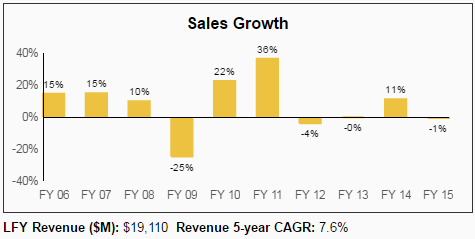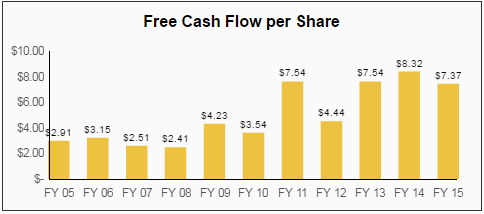Cummins (NYSE:CMI) reported a double-digit sales decline during the second quarter of 2016 and expects full-year revenue to slump about 10%.
Lower truck production in North America and dismal global demand for off-highway vehicles and power generation equipment are weighing on the company.
As the company’s key end markets continue reeling, investors are beginning to wonder how safe Cummins’ dividend payment is.
After all, cyclical industrial businesses are not often the best place to find safe dividends.
Before analyzing Cummins’ dividend, let’s quickly review the business itself. My full thesis on the company can be seen here.
Cummins has been in business for nearly 100 years and recorded total sales of $19.1 billion in 2015. The company manufactures and services diesel and natural gas engines (35% of revenue), electric power generation systems (16%), and engine-related components (22% – e.g. fuel systems, controls, filtration, emission solutions).
Cummins also owns distributors (27%) that provide aftermarket services and support to 7,200 dealer locations.
Some of the company’s representative customers are Fiat Chrysler Automobiles NV (NYSE:FCAU), Daimler AG NA O.N. (DE:DAIGn), Volvo, AB ser. B (ST:VOLVb), Navistar International Corporation (NYSE:NAV), Komatsu Ltd. (T:6301), and Ford Motor Company (NYSE:F).
By geography, North America accounts for 60% of revenue. Europe & the Middle East (14%), Asia Pacific (8%), and China (7%) are also important regions.
Cummins has proven to be a durable business with leading market share positions over the years for several reasons.
The company invests heavily in research and development to ensure its engines comply with extensive regulatory requirements for emission and noise.
In addition to its technology edge, Cummins maintains long-term engine supply agreements with key customers to ensure stable pricing and well-engineered vehicles. New entrants would struggle to crack these sticky relationships.
Customers like Cummins for its technology quality and reliability. The company’s global distribution network has a presence in more than 190 countries, ensuring that appropriate support is in place to service customers’ engines and maximize uptime. Smaller players cannot offer such a comprehensive support network.
Let’s take a closer look at the dividend to see if Cummins can continue making payments despite the downturn in many of its markets.
Cummins’ Dividend Safety
My goal is to never be found holding a company that cuts its dividend. While this is perhaps a lofty objective, I believe that a number of warning signs are given off before a company actually reduces its dividend.
The most likely companies to cut their dividends usually have some combination of high payout ratios, weak free cash flow generation, declining sales and earnings, overleveraged balance sheets, and no proven commitment to paying and growing dividends over time.
Tracking these key metrics is time-consuming, which is why I created a Dividend Safety Score to help me keep tabs on all of these factors for companies I am interested in.
Our Dividend Safety Score analyzes 25+ years of dividend data and 10+ years of fundamental data to answer the question, “Is the current dividend payment safe?”
We look at factors such as current and historical EPS and free cash flow payout ratios, debt levels, free cash flow generation, industry cyclicality, profitability trends, and more.
A Dividend Safety Score of 50 is average, 75 or higher is considered excellent, and 25 or lower is considered weak.
Most companies that end up cutting their dividends score below 25 prior to announcing their dividend reduction.
Kinder Morgan (NYSE:KMI), Potash, BHP Billiton (LON:BLT), and ConocoPhillips (NYSE:COP) all scored below 20 for Dividend Safety before announcing their dividend cuts.
Investors in Cummins can find some relief in knowing that the company has a strong Dividend Safety Score of 82.
Cummins’ payout ratios over the last 12 months remain very healthy, even for a cyclical business. The company’s earnings per share and free cash flow per share payout ratios sit at 53% and 44%, respectively.
Even if Cummins’ free cash flow was cut in half from here, it would still cover the dividend.
Looking further back, we can see that Cummins has historically maintained a relatively low and stable payout ratio, highlighting the company’s consistent earnings generation and conservative capital allocation.
Source: Simply Safe Dividends

Source: Simply Safe Dividends
Of course, Cummins’ business is sensitive to the economy, which is generally not good for dividend safety. The company’s sales fell 25% in fiscal year 2009, and CMI’s stock plunged nearly 60% in 2008, underperforming the S&P 500 by 20%.
The company’s performance during the next recession will likely be a little stronger. Cummins has been acquiring its distributors over the last few years, improving its mix of aftermarket parts and services. Distributors now account for close to 30% of total revenue and should see steadier demand trends throughout a full business cycle.
Source: Simply Safe Dividends
Despite the steep drop in revenue during the last recession, Cummins’ strong cost controls and working capital management preserved free cash flow, which is used to pay out dividends.
As seen below, free cash flow per share edged down just 4% in 2008 and actually increased 76% in 2009 to $4.23 per share, which more than covers the company’s current dividend of $4.10 per share.
Cummins has been an extremely reliable free cash flow generator for more than a decade, strengthening the safety profile of its dividend.
Source: Simply Safe Dividends
Dividend safety can be severely impacted by a company’s balance sheet, especially for cyclical companies such as Cummins.
Dividend payments can be jeopardized if an unexpected downturn in demand hits and a company has too much debt relative to its depressed cash flows. Businesses will always make their debt payments before issuing dividends.
Cummins’ balance sheet is in great shape. The company has $1.28 billion in cash compared to $1.65 billion in total book debt.
No major long-term debt is due until 2023, which gives the company plenty of flexibility to continue reinvesting in its business and returning cash to shareholders even if macro conditions remain soft.
With a long-term debt to capital ratio below 20% and strong credit ratings, Cummins should have easy access to credit markets as well if it ever desired to borrow more money.
Source: Simply Safe Dividends
As a sign of financial strength, Cummins increased its dividend in July by 5.1% despite weak quarterly results.
Management is very committed to the dividend. Cummins has paid uninterrupted dividends since 1993 and increased its dividend every year since 2006.
Shareholders have enjoyed a rising yield on cost and strong double-digit dividend growth rates over the last 20 years, making Cummins one of the fastest income growers in the market.
Source: Simply Safe Dividends
Incremental dividend growth will remain more modest until macro headwinds have subsided, but income investors can sleep well knowing that Cummins’ dividend payments are very safe.
Closing Thoughts on Cummins’ Dividend
Cyclical companies should always be approached with an extra level of caution. While some of their dividend payments are safe, their stock prices can be whipped around with little notice as end market conditions and market sentiment rapidly change.
Despite its higher stock price volatility, Cummins is well positioned to continue paying its dividend even if market conditions worsen.
The company maintains reasonable payout ratios, generates excellent free cash flow, is increasing its mix of stable aftermarket business, has a healthy balance sheet, and has demonstrated its commitment to the dividend for nearly 25 years.
For conservative income investors able to stomach the ups and downs of Cummins’ end markets, the stock’s 3.2% yield could be appealing.
